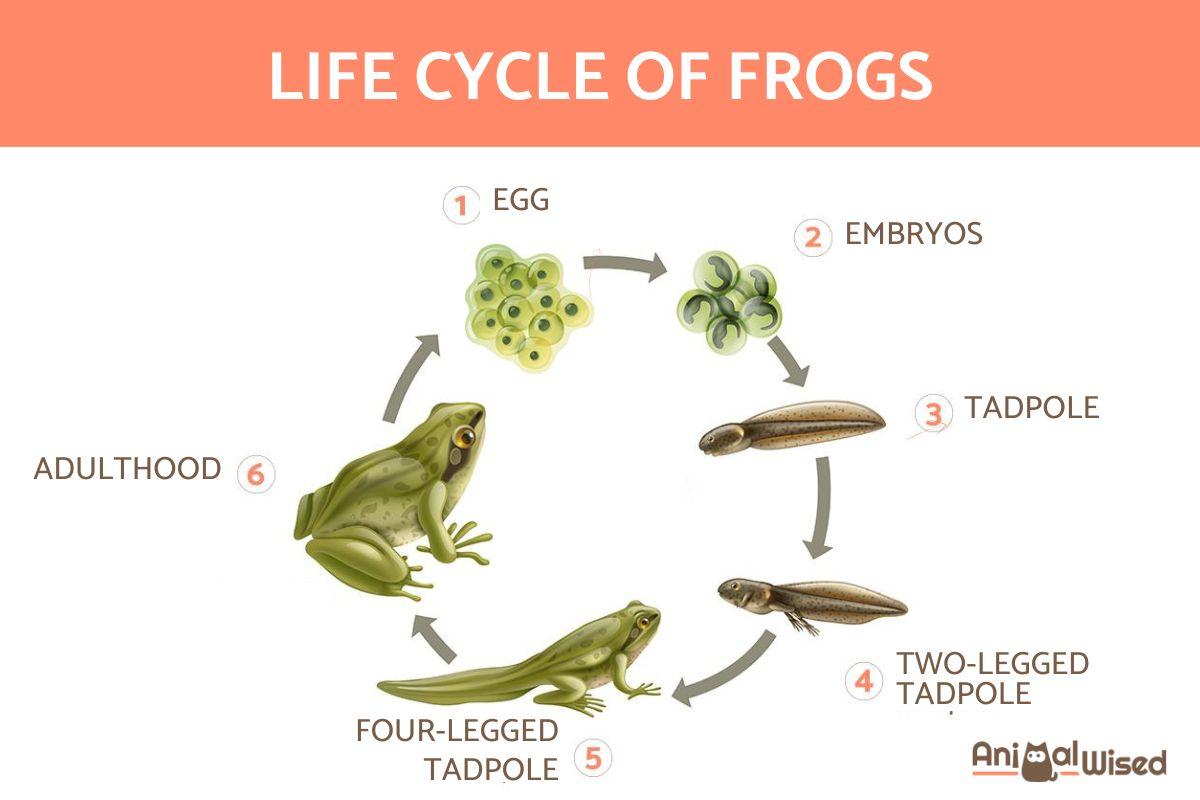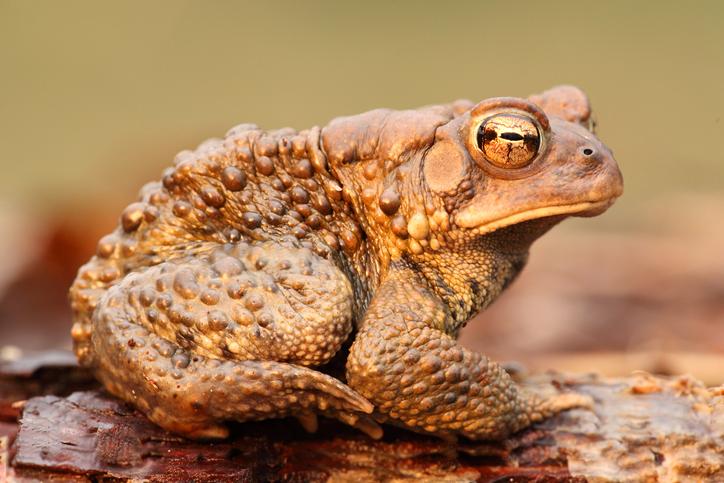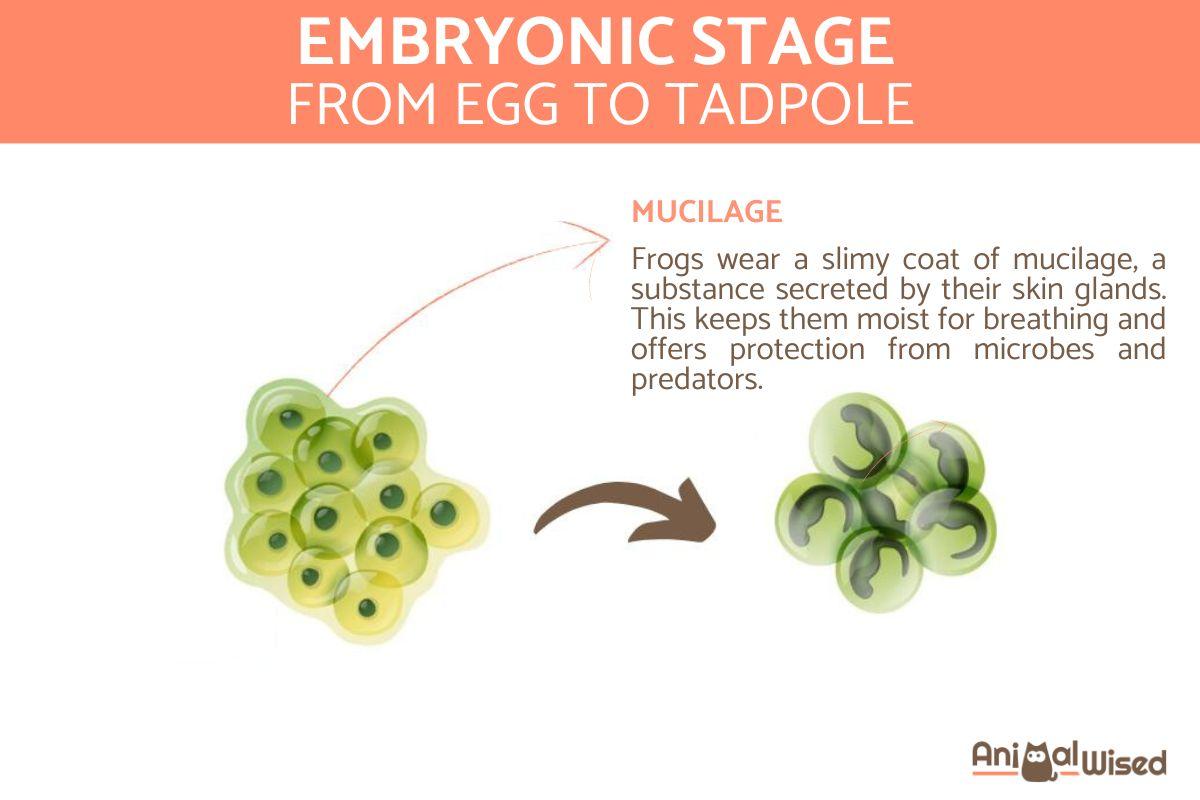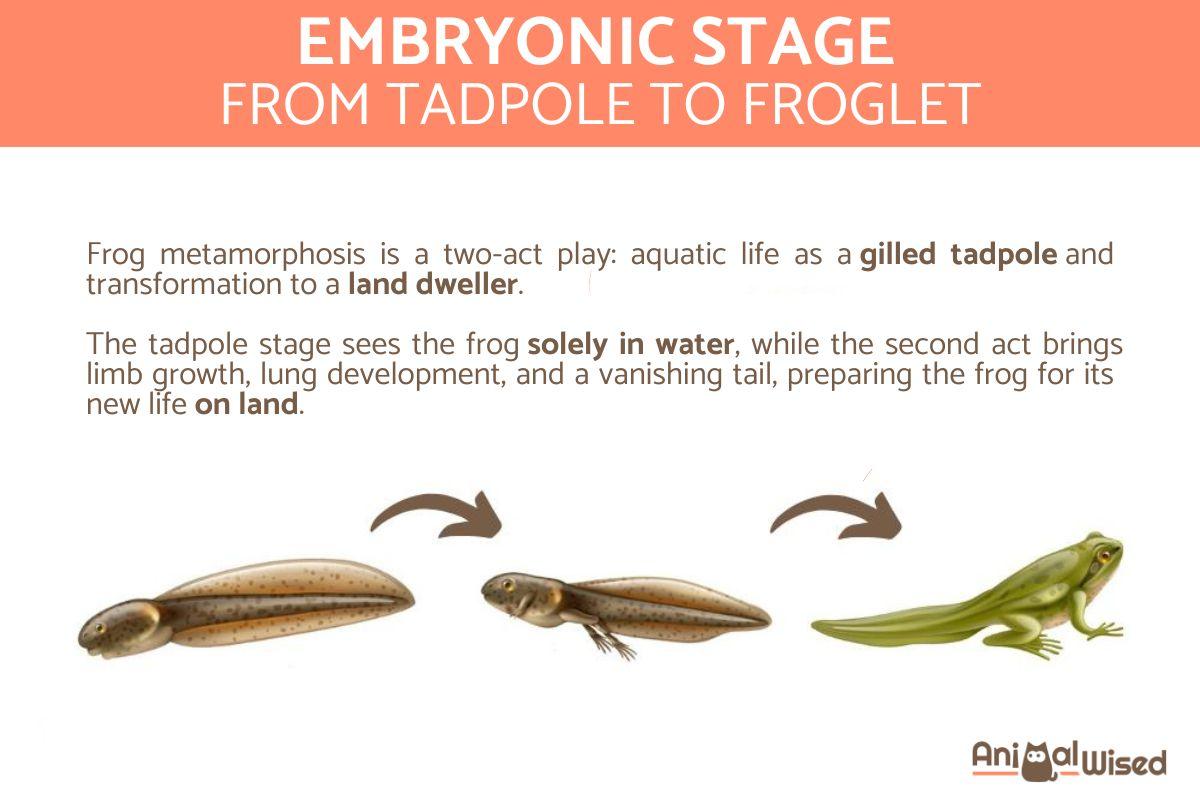Life Cycle of Frogs - Stages of Frog Metamorphosis


There are over 4,800 known frog species found worldwide in a variety of habitats, from rainforests to deserts. They come in a wide range of colors, sizes, and even have unique adaptations depending on their environment. Frogs undergo a remarkable metamorphosis during their life cycle. They start as eggs laid in water, which hatch into tadpoles. Tadpoles are aquatic creatures with gills and tails. Through metamorphosis, tadpoles develop lungs and legs, transforming into adult frogs that can live both on land and in water.
This AnimalWised article will take you through the amazing life cycle of frogs, explaining each fascinating stage.
What is the process of reproduction in a frog?
Frogs (anurans) are dioecious, meaning they have separate sexes: male and female. Additionally, many frog species exhibit sexual dimorphism, where males and females have distinct physical characteristics.
Breeding season for frogs typically occurs in spring. During this time, females with mature eggs migrate to bodies of water. Here, they encounter males who use vocalizations to attract mates.
Fertilization in frogs is external, a process known as amplexus. The male clasps the female in a position called amplexus, which can be either inguinal (around the lower body) or axillary (around the chest). This position stimulates the female to release eggs. Simultaneously, the male releases sperm-laden seminal fluid, fertilizing the eggs externally as they emerge.
Frog eggs are typically surrounded by a gelatinous capsule. This capsule absorbs water, causing the eggs to swell and providing some protection from the environment.
The gelatinous mass serves several purposes. First, the lack of a hard shell on frog eggs makes them susceptible to drying out. Laying them in large masses helps retain moisture. Additionally, the gelatinous material offers some physical protection against bumps and potential predators. It can also act as a barrier against harmful microorganisms.
The specific location where eggs are laid varies depending on the frog species. Some species lay their eggs in large masses attached to aquatic vegetation, while others might deposit them within the rosettes of specific plants.

How are frogs born?
Frogs undergo a fascinating metamorphosis, not a traditional birth.
Within a few weeks of the fertilization, the eggs hatch into young larvae, called tadpoles. These exclusively aquatic creatures have gills for breathing underwater and a tail for swimming. They initially feed on the yolk sac attached to their bodies before developing a mouth and feeding on algae and plants.
Over a period of weeks or months, tadpoles undergo a remarkable transformation. They develop lungs, lose their gills and tail, and grow legs. This process is called metamorphosis.
Finally, the tadpole's body transforms completely, and a tiny frog emerges. When they reach this point, they are ready to live a semi-terrestrial life (hence the name amphibian) although they always need humid places or close to water sources.
While most frog species follow an R strategy, meaning they have many offspring with minimal parental care, some exhibit a K strategy with interesting parental behaviors. Species like the Surinam toad (Pipa pipa), Darwin's frog (Rhinoderma darwinii), and poison dart frogs (Oophaga genus) showcase this.
In these K-strategist species, the male takes a more active role. He protects the eggs laid on the forest floor from predators and even carries water in his cloaca to keep them moist.
Once hatched, the female of these K-strategist species might carry the tadpoles on her back until she places them in suitable locations like bromeliads (rosette-shaped plants). She might even feed them unfertilized eggs until they're strong enough for metamorphosis.
In the upcoming sections, we will explore the distinct stages of metamorphosis experienced by frogs in greater detail. We have organized these stages in the following way:
- Stage 1: Egg
- Stage 2: Tadpole
- Stage 3: Transformation from tadpole to frog
- Stage 4: Adulthood
Intrigued by frog reproduction? Dive deeper in this article.
Stage 1: Egg
A frog's amazing transformation starts within the fertilized egg.
Early on, rapid cell division creates a ball of cells called a blastula. This blastula then undergoes a process called gastrulation. During gastrulation, the cells within the blastula rearrange to form different layers, establishing the basic blueprint for the tadpole's body. This includes the foundation for the digestive system, where the tadpole will eventually process its food.
Next comes neurulation, where a special area called the neural plate thickens. As development progresses, the neural plate transforms into the tadpole's nervous system, which will eventually control its movements and senses – a crucial system for both the tadpole and the adult frog.
Finally, after a period of around 6 to 9 days, depending on the species and water temperature, tiny tadpoles with gills and tails hatch from the eggs, ready to take on their aquatic life.
Ever wondered if frogs have bones? Read on this other article to find out.

Stage 2: Tadpole
The tadpole stage is the second crucial phase in a frog's life cycle. This entirely aquatic stage is characterized by several key adaptations that allow the tadpole to thrive in the water until it's ready for its dramatic transformation into a land-dwelling frog.
Following fertilization, a tiny tadpole emerges from the egg. Unlike a future adult frog, the tadpole has a well-defined head and body, but crucially, it lacks limbs for locomotion at this point.
The tadpole's body is specifically designed for life in the water. A strong, flattened tail acts as a powerful swimming propeller, propelling the tadpole through the water. The ventral positioning of the mouth allows the tadpole to graze on algae and other food sources growing on underwater surfaces like rocks and plants. Behind the mouth, a unique feature called an adhesive disc can be found in some tadpole species. This specialized disc acts like a suction cup, allowing the tadpole to cling to plants or rocks in flowing water. This helps the tadpole maintain its position and avoid being swept away by currents.
On either side of the tadpole's head lie feathery structures called gills. These gills are essential for the tadpole's survival, as they allow it to extract dissolved oxygen from the water, similar to how fish breathe. Unlike adult frogs, tadpoles cannot breathe air yet.
While primarily herbivores feeding on algae and other plant matter, tadpoles exhibit surprising dietary flexibility. Rows of tiny teeth (labial teeth) around their mouths are perfect for scraping vegetation. However, some species are opportunistic feeders. Depending on the availability of food sources, they might consume small invertebrates or even resort to cannibalism if food is scarce.
The tadpole stage is a period of significant growth and development. Here, the tadpole focuses on gathering the nutrients it needs to prepare for the next critical stage – metamorphosis. This remarkable transformation will see the tadpole undergo a complete change, transitioning from an aquatic creature to a land-dwelling frog.
Curious about what tadpoles munch on? Dive deeper in this article.

Stage 3 - Transformation from tadpole to frog
Stage 3 encompasses the entire metamorphosis process itself. It's the dramatic transformation where the tadpole, a fully aquatic creature, changes into a frog - an air-breathing amphibian capable of living both on land and in water (depending on the species). Here is what happens in more detail:
- Hind legs appear first, followed by the forelimbs, gradually transforming the tadpole into a more frog-like shape. These limbs become essential for hopping and maneuvering on land.
- Skin pigmentation develops, transitioning the tadpole from its translucent, aquatic appearance to a more camouflaged or brightly colored form suited for its terrestrial life.
- Through a controlled cell death process called apoptosis, the tail is reabsorbed. This not only streamlines the body for land movement but also provides essential nutrients for the developing frog's organs and tissues.
- Lungs develop within the tadpole's body, while the gills are gradually reabsorbed. This shift allows the frog to breathe air efficiently once it emerges from the water.
- The circulatory and nervous systems undergo significant changes to support the demands of an adult frog. The circulatory system becomes more complex to deliver oxygenated blood throughout the body, while the nervous system refines sensory processing and motor control for life on land.
- Eyes develop eyelids for protection from dust and debris, and the auditory system refines to pick up sounds better suited for a terrestrial environment. This allows the frog to locate prey, evade predators, and communicate with other frogs.
- The tadpole's mouth transforms into a muscular tool perfect for catching prey on land. The tongue becomes protrusible, allowing the frog to rapidly extend it and capture insects and other small invertebrates.
The duration of metamorphosis can vary depending on the frog species and environmental factors. It can take anywhere from a few weeks to several years for a tadpole to become a fully formed adult frog.

Stage 4- Adulthood
Following metamorphosis, the young frog (often called a froglet) will continue to grow and develop.
This period is marked by increasing size, further refinement of adult features, and eventually, reaching sexual maturity. The timeframe for reaching sexual maturity varies depending on the species, but it can take anywhere from a few months to several years. Once mature, the frog can participate in breeding and begin the cycle anew by laying eggs.
As an adult frog, the animal will spend its days hunting for food, avoiding predators, finding mates, and potentially caring for offspring (depending on the species). This stage can last for several years, with some frog species living for over a decade in the wild.
Dive deeper into the fascinating world of frogs. This article explores their amazing anatomy.
If you want to read similar articles to Life Cycle of Frogs - Stages of Frog Metamorphosis, we recommend you visit our Facts about the animal kingdom category.
- Hickman, C.P., Ober, W.C., & Garrison, C.W. (2006). Comprehensive Principles of Zoology , 13th Edition. McGraw-Hill-Interamericana, Madrid. 1022 pp.
- Kardong, K. V. (2007). Vertebrates: Comparative Anatomy, Function and Evolution . McGraw Hill, Interamericana. 782 pp.
- Wake, D.B., & Koo, M.S. (2018). Amphibians . Current Biology, 28(21), 1237-1241.









